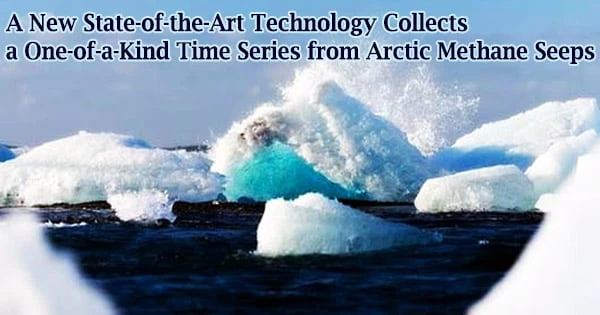A new paper published in Ocean Science connects cutting-edge technology with advances in our understanding of the environment and climate, highlighting and constraining uncertainty in current methane estimates from Arctic methane seep locations.
The K-Lander, an innovative ocean observatory equipped with several ocean sensors built in collaboration between the water column group at CAGE led by Bénédicte Ferré and Kongsberg Maritime, is at the forefront of ocean observatory technologies.
This observatory was built to track methane release from the seabed to the water column in extreme conditions, giving crucial data on the temporal and spatial variability of natural methane emission that could reach the atmosphere.
Time-series data from two methane seep sites offshore western Svalbard, in the Arctic, is presented in a new paper published in Ocean Science by CAGE Ph.D. candidate Knut Ola Dlven and co-authors.
The connection between methane seepage and the ocean is described by these unique data, which demonstrate considerable variability on hourly and seasonal time scales.
“The length and location are what makes these time-series unique, as they answer old and raise new questions related to this variability and how we can better constrain it in future emission estimates,” Says Knut Ola Dølven, Dølven, who conducted this study as part of his Ph.D. at CAGE.
Areas of intense methane seepage
Two K-Lander observatories were erected over two separate intensive methane seepage sites west of Prins Karls Forland in 2015 and 2016, observing thousands of gas bubble streams originating from the seafloor.
It was interesting to observe that, despite the very high short-term variability in methane release, the source of methane emission seemed to be relatively unchanged throughout the 10-month deployment. This has strong implications on future interpretations of methane concentration in seep areas.
Knut Ola Dølven
Despite the fact that methane seep sites are likely to have high temporal and spatial variability, our knowledge of the amount, distribution, and release of methane in the Arctic Ocean has largely relied on studies conducted in the late spring to early autumn when ice and weather conditions were better. Until now.
Long term, continuous monitoring of methane release
Dlven and co-authors processed a 10-month long time series using data from the K-Lander, measuring methane, carbon dioxide, and physical factors at each site. These measurements revealed vital information about methane emissions and concentrations over short and long periods of time.
“It was interesting to observe that, despite the very high short-term variability in methane release, the source of methane emission seemed to be relatively unchanged throughout the 10-month deployment. This has strong implications on future interpretations of methane concentration in seep areas,” Says Dølven.
Because of the weaker water column stratification in the fall and winter, there is a greater risk of methane emission into the atmosphere if seepage continues (increased mixing of the layers in the ocean).
While seabed seepage is a modest natural source of atmospheric methane, the existing and expected emission estimates are subject to significant uncertainty. As a result, Dlven and co-authors were able to identify and constrain uncertainty in methane inventory estimations from seafloor methane seepage.
K-Lander technology in future research applications
This project demonstrated how the marine sector and research teams can work together to provide cutting-edge equipment for detecting methane to help answer issues about oceanic greenhouse gas emissions. This is the first long-term data set in the Arctic that provides superb multi-sensor data on methane emission and other physical and chemical variables.
“This infrastructure will play a major role in understanding factors controlling methane emissions not only in Arctic, as highlighted in this study, but in other locations worldwide as well. Methane seepage data in combination with other parameters measured by the K-Lander will help in estimating present and future global methane budgets in our oceans,” says Bénédicte Ferré, the team leader for WP4 ‘Gas in the Water Column’ and EMAN7, and the responsible for the development, acquisition and data analysis related to the K-Lander.





